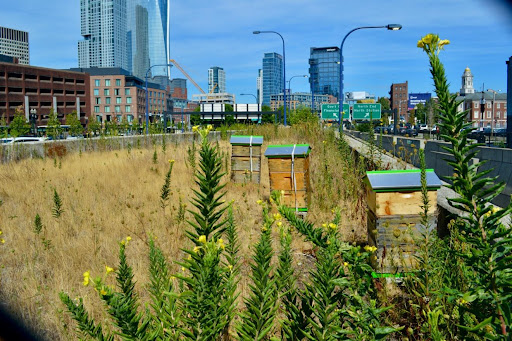Written by Julia Lloyd, Lead Horticulturist
This season you might have noticed The Greenway has been looking a little less green in some areas and a little more brown and crispy. Currently all of Massachusetts is experiencing some degree of drought, but the Boston area specifically is experiencing extreme drought.
Rivers and watersheds throughout the area are running low, but despite this, much of the local flora is doing okay. Our natural ecosystems stand resilient in extreme weather. They have taken millions of years to adapt to the conditions of our geographical region, and for the most part they are holding up despite the lack of water.
Urban flora on the other hand has a tougher time adapting to drought conditions. Plants are up against pollution, runoff, road salt, and reflective heat in addition to climate. These conditions put forth a unique challenge to urban ecology; adapt or perish.
The Greenway is essentially a 1.5-mile-long streetscape between two major roads. Positioned above the 1-93 tunnel, The Greenway soils are much shallower than other parks and public gardens. The combination of regular urban stressors, shallow soils, and heavy traffic emitting hot exhaust into the air surrounding the park can cause the park soil to become hydrophobic. This means that instead of absorbing water, the water just runs off the surface of the soil.
Although some of the plants in the park are showing signs of drought stress, many did well despite the hot and dry conditions.

Joe Pye Weed (Eutrochium purpureum) shone through the hottest days this summer. Even in some of the driest areas of the park, it was in full bloom. A fantastic source of nectar, this North American native perennial is often cloaked in a shroud of bees.

Another North American native wildflower champion this hot and dry season was New York Ironweed (Vernonia noveboracensis). Its bright fuchsia inflorescence towers above its neighboring flora at almost ten feet tall.

Black Eyed Susan’s (Rudbeckia) were stunning this season despite hot and dry conditions. Their familiar bright yellow flowers add a nice contrast to the pinks and purples of Joe Pye Weed.
While the above plantings are intentional, it is also worth noting the plants that have popped up in the park all on their own and look great, but are often viewed as garden weeds. Fleabane, or Erigeron, is a keystone plant, and provides many ecological services to beneficial insects.

Fleabane, or Erigeron, is a keystone plant, and provides many ecological services to beneficial insects.

Another thriving North American wildflower is Evening Primrose (Oenothera biennis) pictured here blooming near our beehives; this area has no irrigation.
In the years to come, consistent horticultural care will give established plantings the best chance at surviving extreme weather. In the meantime, don’t forget to celebrate the plants that are adapting to these extremes and think about how to incorporate them into your own garden!



